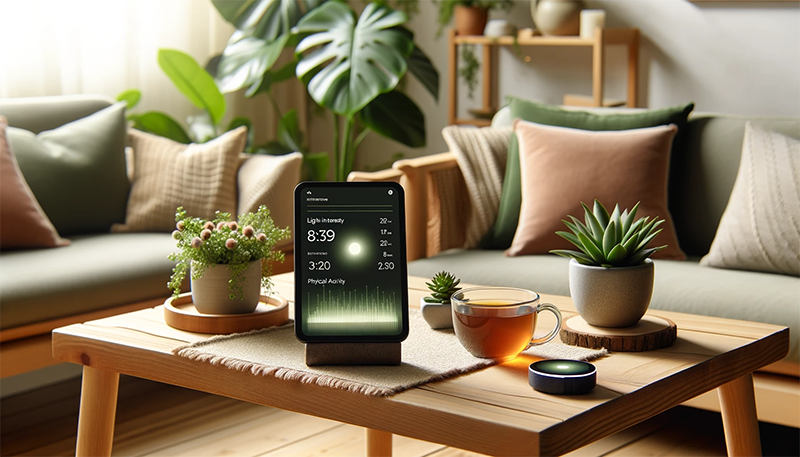Introduction
In today’s fast-paced world, an increasing number of people are leading sedentary lifestyles, which can have detrimental effects on health and well-being. Concurrently, regular physical activity plays a pivotal role in maintaining overall health and preventing chronic diseases. As such, accurately measuring physical activity and sedentary behaviour is essential for both researchers and clinicians alike.
The importance of precise physical activity and sedentary behavior measurements lies in their ability to inform the development of targeted interventions and policies aimed at promoting healthier lifestyles. To achieve this, researchers and clinicians must rely on valid and reliable instruments to assess these behaviors. However, with the wide array of measurement tools available, choosing the most suitable method for a given context can be a daunting task.
The aim of this comprehensive article is to provide an in-depth overview of various sedentary behavior and physical activity measurement methods. We will explore a range of measurement technologies, including questionnaires, accelerometers, and emerging tools, discussing their respective strengths and weaknesses. By understanding these nuances, researchers and clinicians can make informed decisions when selecting the most appropriate measurement tools for their specific needs.
Throughout this article, we will emphasize the importance of validity and reliability in the selection and usage of measurement tools. To this end, we will discuss key considerations such as the target population, the context in which measurements are taken, and the desired outcomes of the research or clinical intervention.
By examining a diverse array of measurement technologies, this article will serve as a valuable resource for researchers and clinicians interested in assessing sedentary time and physical activity levels in various populations. Furthermore, we will provide insights into how these measurements can be used to design and implement effective interventions to promote healthier lifestyles, reduce sedentary behavior, and increase daily physical activity levels.
In summary, understanding and accurately measuring physical activity and sedentary behavior is crucial for researchers and healthcare professionals. This article aims to provide a comprehensive overview of various measurement tools and technologies, emphasizing the importance of validity and reliability. By exploring these measurement methods, we hope to help our readers make informed decisions when selecting the most appropriate tools for their specific needs and ultimately contribute to the promotion of healthier lifestyles.
Sedentary Behaviour: Definition and Impact
Define sedentary behavior and its characteristics
Sedentary behavior refers to activities that require low energy expenditure and involve minimal bodily movement while sitting or reclining. Common examples include sitting at a desk, watching television, or performing desk-jobs. This behavior is characterized by energy expenditure levels of ≤1.5 metabolic equivalents (METs) and a sitting or reclining posture.

Differentiate between sedentary behavior and physical inactivity
Physical inactivity and sedentary behavior are often mistaken for the same concept, but they differ in key aspects. Physical inactivity is defined as insufficient engagement in physical activities such as exercise, sports, or daily chores. In contrast, sedentary behavior focuses on the time spent in low-energy activities while time spent sitting or reclining, irrespective of engagement in physical activity. It is possible for an individual to be physically active while still exhibiting high levels of sedentary behavior.
Discuss the impact of time spent in sedentary behavior on health outcomes
Sedentary behavior is linked to numerous negative health outcomes, affecting both physical and mental well-being. Prolonged sedentary time is associated with an increased risk of cardiovascular diseases, obesity, diabetes, and many types of cancer. Additionally, high levels of sedentary behavior are related to anxiety, depression, and cognitive decline.
Measuring sedentary time accurately is crucial for researchers and clinicians to develop effective interventions and public health strategies. Common methods to measure sedentary behavior include self-reported tools, such as physical activity questionnaires, and objective tools like accelerometers. The latter provides more accurate data on sedentary time and patterns, as well as the intensity and duration of the activity.
In the workplace, sedentary behavior can be assessed using specific tools designed for occupational settings, such as inclinometers and wearable devices. Interventions to reduce sedentary behavior at work include the promotion of active breaks, standing desks, and walking meetings.
One challenge in measuring sedentary behavior is the need for context-specific assessments. For example, sedentary behavior patterns may differ among children, adolescents, older adults, and clinical populations. Choosing the appropriate measurement tools and methods is crucial for accurately capturing these patterns and informing tailored interventions.
Emerging technologies, such as machine learning models, may help to better predict mortality risk related to objectively measured sedentary and inform targeted interventions. Furthermore, virtual coaching and digital health platforms can assist in promoting physical activity and reducing sedentary time.
Physical Activity: Definition and Importance
Physical activity refers to any bodily movement produced by the contraction of skeletal muscles, resulting in energy expenditure. It encompasses a wide range of activities, from daily life activities such as walking, gardening, and housework, to structured exercises and sports. Physical activity can be classified based on its intensity, duration, and type, with varying impacts on health and well-being.
A crucial distinction to make is between physical activity and exercise. Exercise is a subcategory of physical activity, characterized by planned, structured, and repetitive movements with the primary goal of improving or maintaining physical fitness. In contrast, physical activity includes all forms of movement, regardless of whether they are planned or spontaneous.

The importance of physical activity for health and well-being cannot be overstated. Regular physical activity is associated with numerous health benefits, including a reduced risk of cardiovascular disease, Type 2 diabetes, obesity, and specific types of cancer. Additionally, engaging in physical activity can positively impact mental health, reducing the risk of depression and anxiety. In contrast, sedentary behaviour, characterized by low energy expenditure while in a sitting or reclining posture, has been linked to increased health risks.
Assessment of physical activity, posture, and sedentary behaviors is essential for researchers and healthcare professionals to understand individuals’ activity profiles and develop targeted interventions. Various methods are available for measuring physical activity and sedentary behaviour, with each method having its advantages and limitations.
Types of Measurements
Measurement methods for physical activity and sedentary behaviors can be broadly categorized into subjective and objective measurements. Both categories have their strengths and weaknesses, and the choice of measurement depends on the specific research question or clinical context.
Subjective Measurements
Subjective measurements include self-report questionnaires and interviews, where individuals report their physical activity and sedentary behaviour. These methods are cost-effective and relatively easy to administer, making them popular in large-scale population studies. However, subjective measurements may be subject to recall bias and social desirability bias, potentially leading to inaccurate estimations of physical activity and sedentary behaviour levels.

Objective Measurements
Objective measurements, including accelerometers, pedometers, and heart rate monitors, provide more accurate and reliable data on physical activity and sedentary behaviors. These devices typically measure movement or physiological responses to activity and can provide detailed information on activity intensity, duration, and frequency. However, objective measurements may be more expensive and require specialized equipment and technical expertise for data processing.
The choice of a measurement method for assessing physical activity and sedentary behaviour should depend on the specific research or clinical context. In some cases, combining subjective and objective measurements may provide the most comprehensive understanding of individuals’ activity profiles. Ultimately, accurate measurement plays a crucial role in designing effective interventions and promoting health through increased physical activity and reduced sedentary behaviors.

In summary, physical activity is an essential aspect of health and well-being, with numerous benefits for both physical and mental health. Researchers and clinicians should carefully consider the most appropriate methods for measuring physical activity and sedentary behaviors, as an accurate measurement is critical for understanding individuals’ activity profiles and developing targeted interventions.
Characteristics of Physical Activity
Physical activity can vary in terms of intensity, duration, and frequency. Intensity refers to the level of effort required to perform an activity, usually categorized as light, moderate, or vigorous. Duration denotes the time spent in a particular activity, while frequency indicates how often an activity is performed. Physical activity is often classified into different domains, such as leisure-time, occupational, transportation, and household.
Physical activity and health
Engaging in regular physical activity has numerous health benefits, such as reducing the risk of chronic diseases, improving mental health, and enhancing overall quality of life. Some key benefits of physical activity include:
- Reduced risk of chronic diseases: Regular physical activity can help prevent and manage chronic diseases, such as cardiovascular disease, type 2 diabetes, and certain types of cancer.
- Weight management: Participating in physical activity can help maintain a healthy body weight and prevent obesity by balancing energy expenditure with caloric intake.
- Mental health benefits: Physical activity has been shown to improve mental health by reducing symptoms of depression and anxiety, enhancing mood, and promoting cognitive function.
- Bone and muscle health: Engaging in weight-bearing activities and resistance exercises can help maintain and improve bone density, muscle strength, and functional ability.
- Improved sleep quality: Regular physical activity can improve sleep quality and duration, leading to better overall health and well-being.
Given the numerous health benefits of physical activity, it is crucial to promote and facilitate active lifestyles in various settings, including schools, workplaces, and communities. This includes encouraging individuals to engage in a variety of activities that they enjoy and can sustain long-term.

Assessing and measuring physical activity and sedentary behaviors are essential in understanding their impact on health and informing interventions and policies to promote active living. For more information on the assessment of physical activity, posture, and sedentary behaviors, explore our articles on special populations activity and sedentary measurements and older adults activity and sedentary measurements.
In conclusion, physical activity plays a vital role in promoting health and well-being. Differentiating between physical activity and exercise is important, as they differ in their structure and purpose. Physical activity encompasses all types of bodily movement, including daily tasks and leisure activities, while exercise is a subcategory of physical activity that is planned, structured, repetitive, and purposeful, with the primary goal of improving or maintaining physical fitness.
Physical activity promotion
To maximize the health benefits of physical activity, individuals should aim to engage in a combination of activities that they enjoy and can maintain over time. These may include aerobic activities (e.g., walking, running, cycling), muscle-strengthening exercises (e.g., resistance training, bodyweight exercises), and flexibility exercises (e.g., stretching, yoga). Incorporating a variety of activities can help prevent boredom and promote adherence to an active lifestyle.
It is also essential to recognize and address the barriers to physical activity that individuals may face, such as time constraints, lack of motivation, or limited access to appropriate facilities. Strategies to overcome these barriers may include setting realistic goals, finding a workout buddy for social support, utilizing online resources and apps, and incorporating physical activity into daily routines (e.g., walking or cycling to work, taking the stairs instead of the elevator).
Public health initiatives and policies play a crucial role in promoting physical activity and reducing sedentary behaviors across various settings and populations. This can be achieved through the development of safe and accessible environments for physical activity, such as parks, walking trails, and bike lanes, as well as implementing programs and interventions that encourage individuals to engage in regular physical activity.
In summary, understanding the differences between physical activity and exercise, and their respective roles in promoting health and well-being, is essential for individuals and communities to make informed choices and adopt active lifestyles. By engaging in regular physical activity and overcoming barriers, individuals can enjoy the numerous health benefits associated with an active lifestyle and contribute to improved public health outcomes.
Assessment of Sedentary Behavior
Sedentary behavior measurements are essential for understanding the implications of a sedentary lifestyle on health and well-being. Accurate and precise measurements can help researchers and clinicians develop effective interventions to promote healthier lifestyles. This article discusses subjective and objective measurement methods and provides tips for selecting the right tool for your needs.
Subjective Sedentary Time Measurements
Subjective measurements rely on self-report questionnaires and interviews to gather information about sedentary behaviors. These methods are less expensive and less intrusive than objective measurements but may be subject to recall bias and social desirability bias.
Examples of self-report questionnaires and interviews
- International Physical Activity Questionnaire (IPAQ): A widely used questionnaire to assess sedentary behavior and physical activity.
- Occupational Sitting and Physical Activity Questionnaire (OSPAQ): A tool designed to measure workplace sedentary behavior and physical activity.

Tips for choosing the right subjective measurement tool
- Consider the target population: Choose a questionnaire or interview method designed for your specific population (e.g., older adults, children, or workers).
- Evaluate the validity and reliability of the tool: Ensure that the measurement tool has been tested and found to be valid and reliable.
- Balance the level of detail with the burden on participants: Select a tool that provides sufficient information without overburdening participants.
Objective Measurement of Sedentary Behavior
Objective measurements use devices such as inclinometers, accelerometers, and multi-sensor devices to collect data on sedentary behavior. These methods provide more accurate and reliable data than subjective measurements but may be more expensive and intrusive.
Most commonly used objective measurement tools, such as inclinometers and accelerometers
- Inclinometers: Devices that measure the angle of inclination to determine posture and can differentiate between sitting, standing, and lying positions.
- Accelerometers: Devices that measure acceleration and movement, often used to assess physical activity and sedentary behavior.
Multi-sensor devices for sedentary behavior measurements
Multi-sensor devices combine multiple measurement methods to provide a more comprehensive assessment of sedentary behavior and physical activity. For example, an accelerometer may be combined with an inclinometer to better differentiate between sedentary and active behaviors.
Tips for choosing the right objective measurement tool
- Assess the validity and reliability of the device: Ensure the device has been tested and found to be accurate and reliable.
- Consider the target population: Choose a device that is suitable for your specific population, such as older adults, children, or workers.
- Evaluate the feasibility and acceptability of the device: Ensure that the device is easy to use and comfortable for participants.
In conclusion, understanding and addressing sedentary behavior requires accurate and reliable measurement tools. Researchers and clinicians should carefully consider the advantages and disadvantages of both subjective and objective methods and select the most appropriate tool based on their specific needs.
Physical Activity Measurements
Physical activity and sedentary behavior research have gained importance in recent years due to their associations with various health outcomes. Selecting the right measurement tool is crucial for obtaining accurate and reliable results. This article will provide an overview of subjective and objective measures and offer guidance on choosing the right measurement tool.
Subjective Physical Activity Measurements
Subjective measures, such as self-report questionnaires and interviews, rely on participants’ recall and perception of their physical activity and sedentary behavior.
Examples of self-report questionnaires and interviews:
- International Physical Activity Questionnaire (IPAQ)
- Global Physical Activity Questionnaire (GPAQ)
- Sedentary Behavior Questionnaire (SBQ)
Tips for choosing the right subjective measurement tool:
- Assess the validity and reliability of the tool in the target population.
- Consider the questionnaire’s length, administration time, and cost.
- Ensure the questionnaire captures the specific aspects of physical activity and sedentary behavior relevant to your study or clinical context.
Objective Physical Activity Measurements
Objective measures, such as pedometers, accelerometers, and heart rate monitors, provide more accurate and reliable data compared to subjective measures.
Discuss various objective measurement tools:
- Pedometers: count steps and estimate distance walked.
- Accelerometers: measure intensity, frequency, and duration of physical activity and sedentary behavior.
- Heart rate monitors: assess intensity of physical activity based on heart rate [7].
Multi-sensor devices for physical activity measurements:
- Multi-sensor devices combine data from different sensors (e.g., accelerometers, heart rate monitors, video recording) to improve measurement accuracy and precision.
Tips for choosing the right objective measurement tool:
- Evaluate the tool’s validity, reliability, and sensitivity in the target population.
- Consider the device’s cost, wearability, and data management requirements.
- Ensure the device can capture the specific aspects of physical activity and sedentary behavior relevant to your study or clinical context.
Choosing the Right Measurement Tool
Factors to Consider
When selecting a measurement tool, consider factors such as accuracy, reliability, cost, and ease of use. The specific needs of your research or clinical context should guide your decision.
Discuss factors such as accuracy, reliability, cost, and ease of use:
- Accuracy: The degree to which the measurement tool reflects the true value of the variable of interest.
- Reliability: The consistency of the measurement tool across repeated measurements.
- Cost: The expense associated with purchasing, administering, and analyzing data from the measurement tool.
- Ease of use: The simplicity of administering the measurement tool and managing the data collected.
Importance of considering the research or clinical context when choosing a measurement tool:
- Different tools may be more suitable for certain populations (e.g., older adults, children, special populations).
- The specific aspects of physical activity or sedentary behavior being measured may vary depending on the research question or clinical goals.
- The setting (e.g., workplace, home, clinical) may influence the feasibility and acceptability of the measurement tool.
Combining Measurement Tools
In some cases, it may be beneficial to combine subjective and objective measurement tools to provide a more comprehensive assessment of physical activity and sedentary behavior.
Benefits of combining measurement tools:
- Combining tools can address the limitations of each individual tool, such as recall bias in self-report questionnaires and potential device errors in objective measures.
- A combined approach allows for the examination of different aspects of physical activity and sedentary behavior, such as the context, type, and motivation for engaging in these behaviors.
Tips for combining measurement tools:
- Select tools that complement each other and address the specific needs of your research or clinical context.
- Ensure the chosen combination of tools is feasible in terms of cost, time, and participant burden.
Selecting the appropriate measurement tool for physical activity and sedentary behavior is critical for obtaining accurate and reliable data. Consider the specific needs of your research or clinical context, as well as factors such as accuracy, reliability, cost, and ease of use, when choosing a tool. In some situations, combining subjective and objective measurement tools may provide a more comprehensive assessment of physical activity and sedentary behavior.
Conclusion
Accurate measurement of physical activity and sedentary behavior is crucial for understanding the impact of these behaviors on health and well-being. By obtaining reliable data, researchers and clinicians can develop effective interventions, inform public health policy, and monitor population trends in activity levels. Moreover, accurate measurement helps identify patterns and factors associated with sedentary behavior and physical activity, thereby guiding targeted prevention and promotion strategies.
Selecting the appropriate measurement tool is essential for obtaining valid and reliable data on physical activity and sedentary behaviors. Researchers and clinicians should consider various factors when choosing a tool, such as the study population, research question, cost, and ease of use. For example, the Global Physical Activity Questionnaire may be suitable for large-scale population surveys, while accelerometers may provide more detailed information on the intensity, frequency, and duration of activities. Furthermore, the measurement of physical activity and sedentary behavior should account for context and variability, as individuals may engage in different types and patterns of activity throughout the day and across settings.
At Fibion, we offer a range of measurement technologies designed to meet the diverse needs of researchers and clinicians in the field of physical activity and sedentary behavior. Our products are based on the latest scientific research and ensure high levels of accuracy, reliability, and criterion validity. We are committed to supporting our customers in their pursuit of understanding and promoting healthy behaviors.
To further assist you in choosing the right measurement tool for your research or clinical context, we encourage you to explore our range of products and services, including:
- Accelerometers: Providing objective data on activity intensity, duration, and frequency.
- Inclinometers: Detecting posture and differentiating between sitting, standing, and lying down.
- Wearable devices: Offering real-time feedback and personalized insights into individual activity patterns.
In addition to our cutting-edge technology, we provide comprehensive support, including user training, data analysis, and interpretation services. Our team of experts is available to assist you in selecting the most appropriate measurement tools and methodologies for your specific research or clinical needs.
Please visit our website at https://www.fibion.com for more information on our products and services. To discuss your requirements in more detail or request a demonstration of our technologies, do not hesitate to contact us.
Through our commitment to excellence in measurement technology and support, we aim to contribute to the growing body of knowledge on physical activity and sedentary behavior, ultimately promoting healthier lifestyles and improved public health outcomes.
References
Kelly, P., Fitzsimons, C. & Baker, G. Should we reframe how we think about physical activity and sedentary behaviour measurement? Validity and reliability reconsidered. Int J Behav Nutr Phys Act 13, 32 (2016). https://doi.org/10.1186/s12966-016-0351-4
Silva DR, et al. South American Physical Activity and Sedentary Behavior Network (SAPASEN) collaborators. Measurement of physical activity and sedentary behavior in national health surveys, South America. Rev Panam Salud Publica. 2022 Jan 18;46:e7. doi: 10.26633/RPSP.2022.7.
Strain T, Milton K, Dall P, et al. How are we measuring physical activity and sedentary behaviour in the four home nations of the UK? A narrative review of current surveillance measures and future directions British Journal of Sports Medicine 2020;54:1269-1276. http://dx.doi.org/10.1136/bjsports-2018-100355
Kuster RP, Grooten WJA, et al. How Accurate and Precise Can We Measure the Posture and the Energy Expenditure Component of Sedentary Behaviour with One Sensor? Int J Environ Res Public Health. 2021 May 27;18(11):5782. doi: 10.3390/ijerph18115782. PMID: 34072243; PMCID: PMC8198866.
Sjöros T, Vähä-Ypyä H, et al. Influence of the Duration and Timing of Data Collection on Accelerometer-Measured Physical Activity, Sedentary Time and Associated Insulin Resistance. Int J Environ Res Public Health. 2021 May 6;18(9):4950. doi: 10.3390/ijerph18094950. PMID: 34066552; PMCID: PMC8125504.
Kuster RP, Grooten WJA, et al. Is Sitting Always Inactive and Standing Always Active? A Simultaneous Free-Living activPal and ActiGraph Analysis. Int J Environ Res Public Health. 2020 Nov 28;17(23):8864. doi: 10.3390/ijerph17238864. PMID: 33260568; PMCID: PMC7730923.
Paul D. Loprinzi, Bradley J. Cardinal. MEASURING CHILDREN’S PHYSICAL ACTIVITY AND SEDENTARY BEHAVIORS. Journal of Exercise Science & Fitness. Volume 9, Issue 1, 2011, Pages 15-23. https://doi.org/10.1016/S1728-869X(11)60002-6
Andrew J Atkin, Trish Gorely, et al. Methods of Measurement in epidemiology: Sedentary Behaviour, International Journal of Epidemiology, Volume 41, Issue 5, October 2012, Pages 1460–1471, https://doi.org/10.1093/ije/dys118
Boudet G, Chausse P, et al. (2019) How to Measure Sedentary Behavior at Work? Front. Public Health 7:167. doi: 10.3389/fpubh.2019.00167
Alan L. Smith, Stuart J.H. Biddle. Youth Physical Activity and Sedentary Behavior1st edition. Challenges and Solutions. ISBN: 0736065091, ISBN-13:9780736065092.
Chen M, Landré B, Marques-Vidal P, et al. Identification of physical activity and sedentary behaviour dimensions that predict mortality risk in older adults: Development of a machine learning model in the Whitehall II accelerometer sub-study and external validation in the CoLaus study. EClinicalMedicine. 2022 Dec 13;55:101773. doi: 10.1016/j.eclinm.2022.101773. PMID: 36568684; PMCID: PMC9772789.
Kelly P, Fitzsimons C, Baker G. Should we reframe how we think about physical activity and sedentary behaviour measurement? Validity and reliability reconsidered. Int J Behav Nutr Phys Act. 2016 Mar 1;13:32. doi: 10.1186/s12966-016-0351-4. PMID: 26931142; PMCID: PMC4772314.
Must, A., Tybor, D. Physical activity and sedentary behavior: a review of longitudinal studies of weight and adiposity in youth. Int J Obes 29 (Suppl 2), S84–S96 (2005). https://doi.org/10.1038/sj.ijo.0803064
Crowley P, Ikeda E, et al. The Surveillance of Physical Activity, Sedentary Behavior, and Sleep: Protocol for the Development and Feasibility Evaluation of a Novel Measurement System. JMIR Res Protoc 2022;11(6):e35697
doi: 10.2196/35697. PMID: 35666571. PMCID: 9210205
Ryan DJ, Wullems JA, Stebbings GK, et al. Reliability and validity of the international physical activity questionnaire compared to calibrated accelerometer cut-off points in the quantification of sedentary behaviour and physical activity in older adults. PLoS One. 2018 Apr 19;13(4):e0195712. doi: 10.1371/journal.pone.0195712. PMID: 29672534; PMCID: PMC5908192.
Castillo-Retamal, Marcelo and Hinckson, Erica A. ‘Measuring Physical Activity and Sedentary Behaviour at Work: A Review’. 1 Jan. 2011 : 345 – 357. DOI: 10.3233/WOR-2011-1246
Priscila Marconcin, Pedro B. Júdice, et al. Methods of Assessing Sedentary Behaviour. DOI: 10.5772/intechopen.99567
Silva DR, Barboza LL, et al. South American Physical Activity and Sedentary Behavior Network (SAPASEN) collaborators. Measurement of physical activity and sedentary behavior in national health surveys, South America. Rev Panam Salud Publica. 2022 Jan 18;46:e7. doi: 10.26633/RPSP.2022.7. PMID: 35350459; PMCID: PMC8956968.
Byrom B, Stratton G, Mc Carthy M, Muehlhausen W. Objective measurement of sedentary behaviour using accelerometers. Int J Obes (Lond). 2016 Nov;40(11):1809-1812. doi: 10.1038/ijo.2016.136. Epub 2016 Aug 1. PMID: 27478922; PMCID: PMC5116050.
Carson V, Wong SL, et al. Patterns of sedentary time and cardiometabolic risk among Canadian adults. Prev Med. 2014 Aug;65:23-7. doi: 10.1016/j.ypmed.2014.04.005. Epub 2014 Apr 13. PMID: 24732719.
Holtermann A, Schellewald V, et al. A practical guidance for assessments of sedentary behavior at work: A PEROSH initiative. Appl Ergon. 2017 Sep;63:41-52. doi: 10.1016/j.apergo.2017.03.012. Epub 2017 Apr 11. PMID: 28502405.











